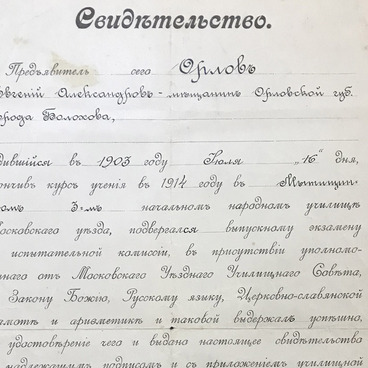The certificate of a torpedoman on the battleship Sissoi Veliky in our exposition used to belong to Pavel Pavlovich Yakovlev. Born in Moscow in 1876, he was orphaned at a very early age and was brought up by his aunt. Pavel Yakovlev graduated elementary school and was bound apprentice to a small plant that produced churchware. There, he learned engraving, metalsmithing, and the basics of galvanization. After that, he graduated from the naval school for petty officers. The training process was very hard and demanding.
Pavel Yakovlev was appointed a torpedoman on the Sissoi Veliky battleship. Torpedomen were responsible for maintaining the ship’s weapons. The skills he gained at the plant came in handy during his service in the Navy. The Sissoi Veliky battleship was a part of the Second Pacific Squadron during the voyage to the Far East and participated in the Battle of Tsushima in the Sea of Japan. An attack of Japanese destroyers left the battleship seriously damaged. Pavel Yakovlev was among the last ones to leave the ship. He and another sailor were taken captive by the Japanese. And once again, the skills he had learned at the churchware factory proved to be useful. He weaved lace-like chainwork out of horse-hair, carved figurines of people and animals, and made engraved patterns. The Japanese were quick to purchase his inexpensive craftwork. The money he earned helped feed his fellow captives.
After the war, Pavel Yakovlev returned to Russia and continued to serve in the navy. Once discharged, he worked as a foreman at a power station. He was one of their best experts in electric motors. In the years of the Revolution and the Civil War, Pavel Yakovlev served in the Volga warship flotilla as a mining expert. He worked on ships and at power stations in the Russian south. Then he moved to Moscow with his family and worked as a foreman at an electromechanical plant until his retirement. During the Great Patriotic War, he continued to work toward helping his country.
Pavel Yakovlev was awarded the medal “For Defense of Moscow” and “For Brave Work During the Great Patriotic War of 1941–1945.” He was also keen on preserving his medal for participation in the Russo-Japanese War. The veteran of three wars passed away in 1959.
Pavel Yakovlev was appointed a torpedoman on the Sissoi Veliky battleship. Torpedomen were responsible for maintaining the ship’s weapons. The skills he gained at the plant came in handy during his service in the Navy. The Sissoi Veliky battleship was a part of the Second Pacific Squadron during the voyage to the Far East and participated in the Battle of Tsushima in the Sea of Japan. An attack of Japanese destroyers left the battleship seriously damaged. Pavel Yakovlev was among the last ones to leave the ship. He and another sailor were taken captive by the Japanese. And once again, the skills he had learned at the churchware factory proved to be useful. He weaved lace-like chainwork out of horse-hair, carved figurines of people and animals, and made engraved patterns. The Japanese were quick to purchase his inexpensive craftwork. The money he earned helped feed his fellow captives.
After the war, Pavel Yakovlev returned to Russia and continued to serve in the navy. Once discharged, he worked as a foreman at a power station. He was one of their best experts in electric motors. In the years of the Revolution and the Civil War, Pavel Yakovlev served in the Volga warship flotilla as a mining expert. He worked on ships and at power stations in the Russian south. Then he moved to Moscow with his family and worked as a foreman at an electromechanical plant until his retirement. During the Great Patriotic War, he continued to work toward helping his country.
Pavel Yakovlev was awarded the medal “For Defense of Moscow” and “For Brave Work During the Great Patriotic War of 1941–1945.” He was also keen on preserving his medal for participation in the Russo-Japanese War. The veteran of three wars passed away in 1959.



